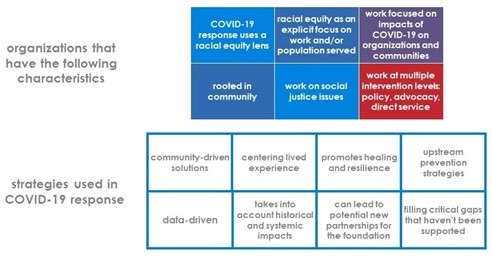
TC Duong
Program Officer
Blue Shield of California Foundation
I would love to take credit for Blue Shield of California Foundation’s (BSCF) COVID-19 and Racial Equity grants, but I have to acknowledge the great work of our Program Managers, Jelissa Parham, Hilary Smith, and Glenda Monterroza, and Program Coordinator Maria Garcia Chinn. This set of grants was designed to support work rooted in Black, Indigenous, and People of Color (BIPOC) communities to address the current COVID-19 crisis and also work toward systemic redesign and upstream solutions. To say these grants were successful is an understatement—the final set of grantees serve a wide range of Californians with unique aspirations including: Black, Indigenous, Latinx, Asian and Pacific Islander, immigrant, farmworker, regional, and rural communities. We also supported grants to two national organizations, the NDN Collective, which works with Native communities, and Grantmakers for Girls of Color. When invited to write about our work for Grantmakers In Health, I connected with the team to explore how they identified a set of grants that was responsive to the moment while also seeking to increase health and equitable opportunity for communities of color over the long term.
COVID-19 Led to Rapid Learning and Operational Change
These grants were built on BSCF’s recent experience with COVID-19 grantmaking. Glenda Monterroza noted that we became nimbler and more responsive by working with community foundations. “They were incredible partners in quickly deploying resources out to communities,” said Monterroza.
A detailed analysis of our COVID-19 funding revealed that the foundation’s support began to decrease in the fall, at a time when the pandemic’s impact was continuing to grow, particularly in BIPOC communities. Our team also identified geographic pockets that were impacted differently by the pandemic, such as the Central Valley and Los Angeles. Through further analysis, the team determined the key populations whose health was most impacted by COVID-19, including immigrants, farmworkers and other essential workers, Black communities, and Indigenous communities.
Setting Clear and Specific Criteria
With an initial funding pool of $700,000, the team had to be specific and intentional with their criteria to support specific populations in specific geographies. They spent a great deal of time crafting questions that addressed:
- Capacity to work with and in communities
- Strength and diversity of grantee partnerships
- A focus on policy and systems change work
- The integration of community member’s lived experience
Jelissa Parham shared that key informant interviews were an important first step in assessing the landscape for this funding. “Figuring out which organizations were doing the work, doing it well, and were reaching the communities disproportionately impacted. This ‘snowball interview’ process really lifted up some organizations that perhaps would not have been funded otherwise. The beautiful piece was that after enough interviews, we started to hear similar names being suggested! The criteria shifted a good amount based on our conversations with community partners. The interviews really shed light into what the need was, who was being impacted in specific communities, and how they were trying to implement these upstream prevention methods,” said Parham.
This early work surfaced key criteria for this round of grantees, which included:

“I think we ensured equity was front and center by identifying the populations that felt the compounding impact of both COVID-19 and historical and systemic racial inequities; and then focused on funding organizations with community-driven solutions informed by lived experience to ensure solutions were working for those most impacted. For regranting organizations, they had to have participatory grantmaking strategies or community advisory committees to ensure that community voices were centered. I would say equity was a driving force in the organizations we selected,” said Hilary Smith.
Among those who experience the pronounced compounding impacts of COVID-19 are essential workers, including grocery store workers, food workers, factory workers, and farmworkers. They all make up the chain of our food distribution process. Monterroza noted, “seeing the now viral photo of farmworkers, working amidst an orange fire (because of the wildfires), really struck home. These workers, primarily immigrants from Mexico and Central America in California, were largely left out any type of safety net services and supports.” To address this widening gap, organizations such as Líderes Campesinas, Centro Binacional para el Desarrollo Indígena Oaxaqueño, and the California Rural Legal Assistance Foundation were funded to advocate for additional services and supports for the nearly 800,000 farmworkers in California.
Connecting to the Future
Seeing the need and the number of organizations that were working at the intersection of racial justice and COVID-19, our President and CEO Debbie Chang allocated additional funds so that total amount of grants under this fund increased to $1,359,000.
Parham shared that this funding helped regranting organizations leverage our funds to receive additional funding from other sources. For example, Grantmakers for Girls of Color was a new partner but could potentially help attract other funders and result in an ongoing partnership, which is emerging.
In the end, the team put forward an amazing set of grants that reflected the complexity of work related to racial justice and COVID-19. These grants were focused on the communities most affected by COVID-19 and the organizations and work that are leading us toward systems change. This was the result of rapid learning from the first round of COVID-19 funding, research and data collection, and willingness to explore our own barriers.
This work will continue to be powerful model for us as we operationalize equity in our grantmaking process and create new partnerships and relationships. I am impressed by the intentionality of this team and how they translated this intention to real results that is felt in communities.
